Last November, Mickalene Thomas was named a 2015 USA Francie Bishop Good & David Horvitz Fellow, one of 37 artists across nine disciplines to receive a $50,000 unrestricted award to expand and facilitate their practice. Thomas joined a list and network of lauded names that include visual artists like Theaster Gates and Mark Bradford, but also musicians like Meshell Ndegeocello and fashion designers like Rodarte. The grant is not only an honor because of its national and international recognition and its unbounded terms, but because it is given by an anonymous nominating system of artistic peers.
When Whitewall spoke to Thomas at her studio, she sounded excited, humbled, and utterly surprised that she had been named a fellow. She shared with us that, while she has experienced institutional and commercial success (she had just opened a show at the Aperture Foundation in New York in March and started to ship work to the Aspen Art Museum for her solo show “Mentors, Muses, and Celebrities,” which closed June 12), recognition from her peers gave her the boost and confidence to start the new chapter of her career.
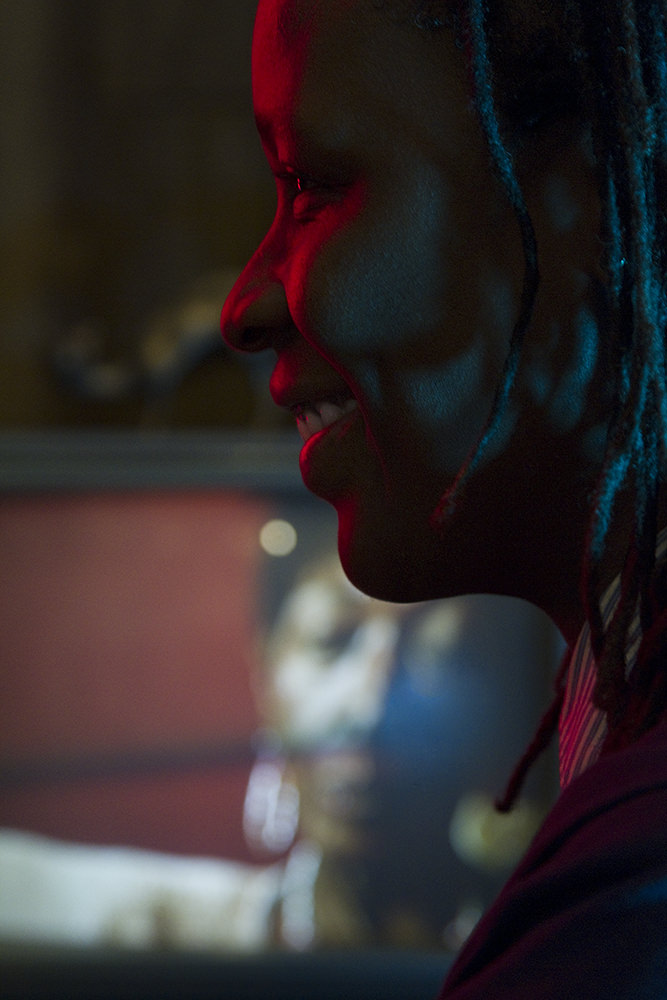
and Artists Rights Society (ARS), New York
Her next museum show opens this October at the Museum of Contemporary Art Los Angeles, and is entitled “Mickalene Thomas: Do I Look Like a Lady?” We spoke with the artist about how she collaborates with other artists (a new thing for her), the role of photography in her work, and learning to see, understand, and love our mothers.
WHITEWALL: Let’s start with the Aperture show, since that is up now, which has photos from the past 15 years and came from the recently published book Muse. You’ve said how the photographic image has always been a touchstone in your practice. How is the photograph fitting into the work you’ve been making lately?
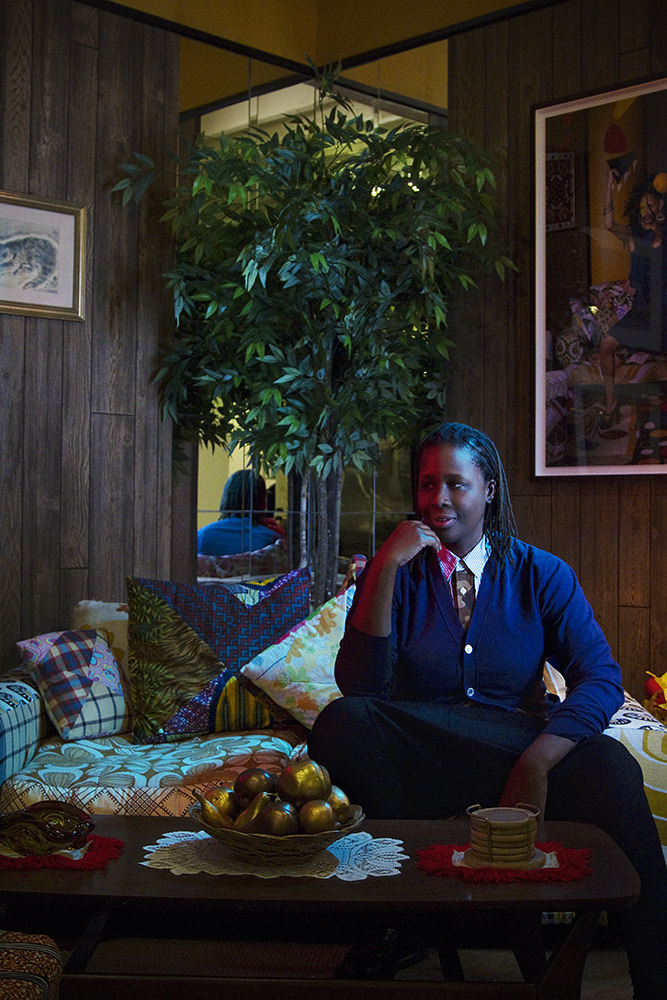
MICKALENE THOMAS: I’m trying to articulate my frame of mind—just thinking about the photographs on their own really makes me think about the power of those particular images. When I come back to the studio, I’m really being selective about what images are photographic images and what images I’m going to use only for the paintings, so that they’re different, in that if I do make it a photograph, that it can’t be a painting; allowing it to just be that photographic image. That’s what I’ve taken from [the Aperture show].
Like if I take Lovely Six Foota, for instance, she’s sitting there, with her legs slightly open, and with the blue of the mirror coming through. That doesn’t really need to be a painting. It is what it is. It has its own power. I don’t need to redo that. It doesn’t need to be in a transformation in a painting at all. You know? So to really understand that this image is doing everything I want it to do, and I don’t need to try to push it any further in a different medium.
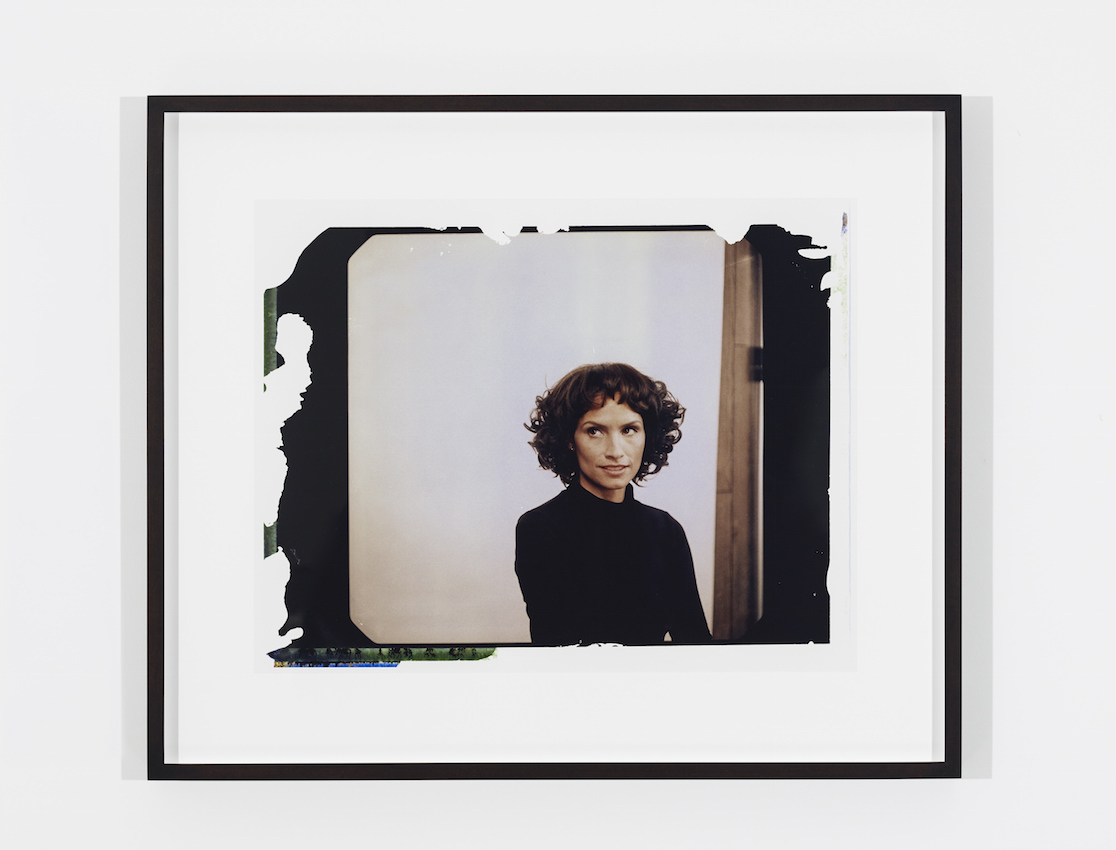
Photo by Steve Benisty
WW: So how do you choose then when to push an image further, and to bring it into the medium of painting?
MT: When I want to bring out more, or if I don’t really understand what’s happening in it. I try to use other mediums to express it, to see if I can really understand—and it’s more about me understanding, myself. And that’s why an image [like Lovely Six Foota] never became a painting. It doesn’t need to. It was powerful in a different way. I think with Lovely Six Foota, it was a very clear statement, a powerful, “Here I am, this is me”—boom.
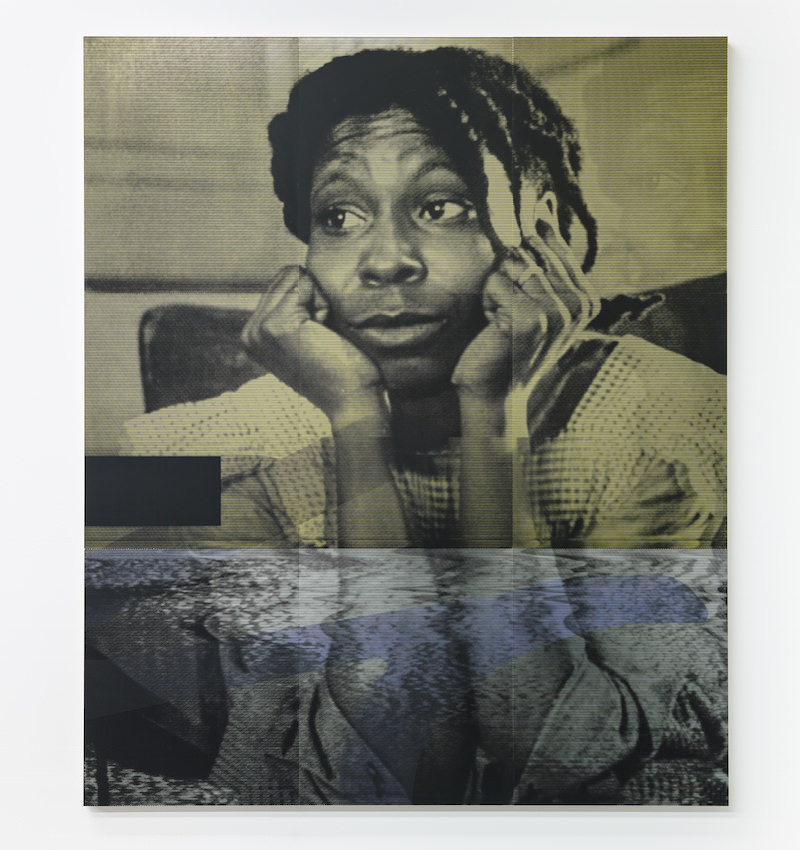
Photo by Steve Benisty
WW: In the show is an installation of photos and key images that have inspired you, called “tête-à-tête” with works by Derrick Adams, Renée Cox, LaToya Ruby Frazier, Lyle Ashton Harris, Deana Lawson, Zanele Muholi, Malick Sidibé, Xaviera Simmons, Hank Willis Thomas, Carrie Mae Weems. How did that become a part of the show?
MT: [It came from] as an artist, thinking about artist communities and our relationships with other artists and our peers, these conversations that we have with one another, and we’re all in this space together, right? Collectively. There’s a consciousness that’s happening, if you’re present and aware. And even if it’s communicated or not, we’re speaking some of the same languages. For me, as an artist, learning photography, it was really important for me to put forth some of these artists that I was looking at to make myself a better photographer. And I just wanted to really pay respect to that.
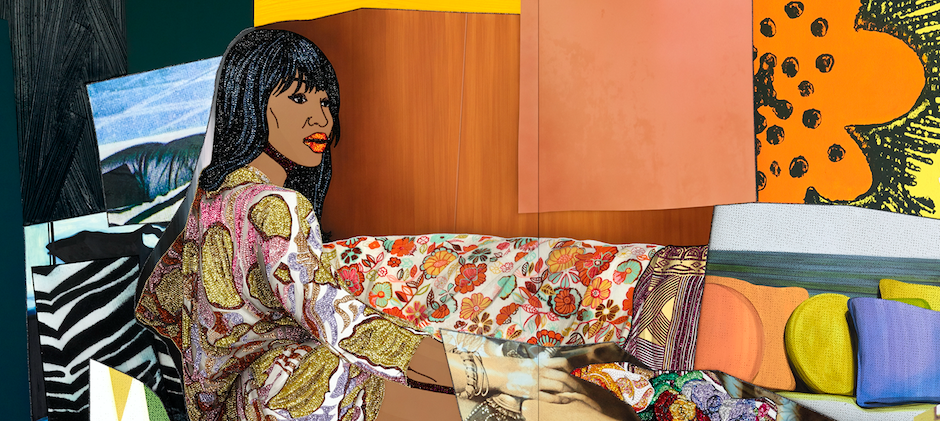
Photo by Steve Benisty
It came out of a conversation, a public talk that I had at MoMA, which was a conversation among friends, with Derrick Adams, Xaviera Simmons, and Clifford Owens all on a panel together. One conversation came up about collaboration. And out of the four of us on stage, I was the only one who’s never really fully collaborated. I’m sitting there, kind of freaking out, and I’m like, “Ugh, I’m just an independent artist . . .” But someone just asked me the question, “Mickalene, have you ever collaborated?” And just really thinking fast on my feet, answering honestly, I said, “No,” but also how if I would collaborate what this is what I would do, and I described “tête-à-tête.”
I’m really interested in using the platforms that I have with some of these other artists that are my friends and colleagues and mentors. It’s not about doing it when I’m dead. Let’s plan on doing it now! I don’t want someone doing it when I’m dead. I want these conversations to happen now.
WW: Speaking of showing respect to colleagues, I wanted to congratulate you on the United States Artists Fellowship you were awarded early this year, which is awarded based on a nomination from your peers.
MT: Thank you!
WW: What does that sort of award mean for you?
MT: I guess what it means for me is this kind of recognition, and a nod to, “We want to show our appreciation for the work you’re doing.” So it was really unexpected for me to receive it—there was no expectation, and I was actually really taken aback and honored. That’s just a great feeling—that a collective group of people in the art world in various fields come together to talk about these artists they feel are deserving of these awards. For me, it was like winning the MacArthur. It’s not, but, you know.
WW: Hey, you can call yourself a genius! [Laughs]
MT: I was really thankful, and honored, because sometimes, I’m making work and I’m not even thinking about how other people are thinking about me. I don’t know. I think it’s good, every once in a while, for artists to just get that sort of recognition. Because it did lift my spirits. It just made me feel really happy, and like, “Okay, I am doing some good stuff.”
I think people sometimes think, “Oh, they’re okay, they don’t need . . .” but, you know, it did really put some more fire under me. Because it’s sort of the [start to] the next chapter of my career, whatever direction that may go. It did boost me. Now I’m working toward the next decade of my life, and I can really do something and create some challenges for myself.
WW: I wonder, with an award like that, if it can give you a nudge to take a risk or pursue a new direction in your work?
MT: Yeah. I’ve been thinking about constructing panels in a different way, and I’ve been a little hesitant about it. But now we’re actually moving forward and working in this material that I’ve been curious about. I’ve been doing a lot of silkscreens, so I got a new press, and it’s really allowed me to expand my studio practice confidently. Because before, I was hesitant, now it’s like, “Let’s do this.”
WW: Speaking of a new direction, at Art Basel Miami Beach last December, there were three of your sculptures at Kavi Gupta Gallery’s booth that I was surprised by. They were wall sculptures that were enlarged costume jewelry of your mother’s, I believe. They sort of expand some of the ideas explored in your 2014 show “I was born to do great things.” I loved them! Can you tell me about the process of creating those?
MT: Yeah, that show was about my relationship with my mother. I love working with Kavi, because he has such a vision and is such a great supporter of artists, with “You’ve got the idea? Just do it!” He’s such a cheerleader for you, a foundation. He’s like, “What’s your craziest idea? If you could do it, what would it be?” And that’s what that was, from “I was born to do great things.” While I was making that work, I’m sitting there, thinking what does this look like, if it was this scale? And I remember saying that to him and he said, “Well, why don’t you just do one?”
I just started thinking about some of the brooches my mother wore. I picked the ones that were her favorites and thought, “What if I transformed them from this really kitsch jewelry to something a little more modern, into art, into modernism, to create a different energy from it that’s not just precious? [To create] these objects of desire that are sculpture. They’re transformed from their familiar territory.
That excited me, to think about how I could continue conversations around my mother, but not in a literal sense, but something abstract. It was about her, but now it’s not about her, allowing that conversation to evolve and using it as a thread to make the work. I always wanted to do sculpture, and never really knew how to find a way to create that space within my studio. It has to make sense, to me. It has to evolve out of the work itself. It has to connect in some way to what I’m doing already. Otherwise, it’s just a pile of junk sitting in the studio that I have.
WW: When you learn the backstory behind those sculptures, it is so personal to your life. But on its own, you don’t have to view it from that angle.
MT: And that’s what I wanted. “I was born to do great things” was so rooted in that space of the personal. This was the growth from that. Now, it’s matured. Now, it’s inspired.
WW: One thing I wanted to talk to you about was the work you did with your mother, and the film you did, where you interviewed her, Happy Birthday to a Beautiful Woman. In the interview, you talked about how nervous you were to interview her, and how you think that should be required of all parents. That resonated with me. I think that should be required of all women, to interview our mothers. I’ve learned things about my mother recently that make me love her more, and it’s only when I ask those questions . . .
MT: It makes you look at the whole person, right? You sort of understand, “However she is, and whoever she is has nothing to do with me, just like who I am.” We’re an extension of them, but we really have nothing to do with them in that sense of the course that we take within our lives. And we need to understand that, and respect that. And not hold that against them—don’t be upset with them about some of their choices. Just, in the same way we don’t want them to be upset with us about some of our choices. Because we’re our own people. And it took me a while, just because of some of the things my mother went through, to not take it on as my responsibility. You know what I mean? It has nothing to do with me. Yeah, I’m a part of her, but none of those choices she made have had anything to do with me. Those are her choices. That’s her as her person. And then I can love her as the person that she was! Because I can separate that person from my mother!
WW: Yes!
MT: It’s what we do with our friends. I had to do that in order for me to have a relationship with her, because otherwise I wouldn’t have a relationship with her because I was holding so much inside, not expressing it, and blaming her for it. And you just can’t. Because her choice of choosing to do drugs had nothing to do with me. But what it did was make me a stronger person. I understood why she protected me in certain ways, or really pushed me forward in other ways and encouraged me to go out into the world, and to experience the world and travel, because she didn’t want me to make the mistakes that she did.
WW: Our relationship with our mothers is so tied up in who we are.
MT: And it’s what I’m really pulling from in my new body of work for my show in Aspen. It’s thinking about The Color Purple, really, the book and the film, the relationships between Celie and Shug Avery, this sisterhood and how they give each other strength. And through each other’s strengths and weaknesses, they each become confident on their own terms, at different times throughout the film. And maybe get to see each other through themselves. They become the mirror for one another. They become the source of inspiration, desire, and confidence. It goes back and forth at different times, when one becomes stronger than the other, and vice versa, and it keeps doing that. That’s why I think The Color Purple, the film and the book, the musical, has so many iterations. Because it’s generationally timeless. Because you can relate to all of those female characters throughout the film.
WW: So how will that fit into your show of video and film work in Aspen?
MT: I’m using excerpts of that film for my show in Aspen. I’m very excited about it. We still have some editing to do with some of the films, but that’s what’s so exciting with film and video. You plug it up and you’re good to go.
This article is published in Whitewall‘s summer 2016 Design Issue.








